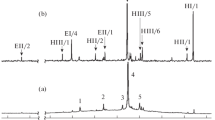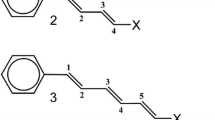Abstract
An additive generative function method previously proposed has been used to derive analytic expressions for the charge and bond-order distributions in polymethine chains for binuclear polymethine compounds. The π-electron wave amplitude is determined primarily by the electron-donor capacity in the terminal groups at the edges and in the difference of those capacities at the center. The electron-donor capacity governs the charge exchange between a terminal group and the chain in the ground state. That approximation gives a rigorous basis for the terms used in the literature: polymethine and polyene types of compound, as well as for the smooth transition between them.
Similar content being viewed by others
Literature cited
G. G. Dyadyusha and M. N. Ushomirskii, “Effective additive fragment parameters for binuclear polymethine dyes,” Teor. Eksp. Khim.,21, No. 3, 268–279 (1985).
G. G. Dyadyusha and M. N. Ushomirskii, “Molecular-orbital coefficients for binuclear polymethine dyes in the effective additive parameter method,” ibid.,22, No. 2, 137–146 (1986).
G. Korn and T. Korn, Mathematics Handbook for Scientists and Engineers [Russian translation], Nauka, Moscow (1970).
R. Peierls, Solid-State Quantum Theory [Russian transition], Izd. Inostr. Lit., Moscow (1956).
S. Dähne and D. Leupold, “Der Polymethizustand. 3. Mitteilung über allgemeine Zusammenhänge zwischen Farbe und Struktur organischer Verbindungen,” Ber. Bunsenges, phys. Chem.,70, NO. 6, 618–625 (1966).
A. I. Tolmachev, M. Yu. Kornilov, and E. F. Karaban, “Polymethine-dye protonation directions,” Teor. Eksp. Khim.,12, No. 6, 817–821 (1976).
E. A. Morris and E. F. Mooney, “Structure of monomethine oxonols and intermediates derived from rhodanide. Spectral investigations,” Ind. Chim. Belge, Ser. 2,32, Spec. No., Part 3, 86–89 (1967).
L. G. S. Brooker, “Spectra of dye molecules. Absorption and resonance in dyes,” Rev. Mod. Phys.,14, No. 2, 275–293 (1942).
G. G. Dyadyusha, I. V. Repyakh, and A. D. Kachkovskii, “A quantum chemical study on charge distributions in symmetrical polymethine-dye cations,” Teor. Eksp. Khim.,20, No. 4, 398–406 (1984).
G. G. Dyadyusha, I. V. Repyakh, and A. D. Kachkovskii, “A quantum chemical study on bon order in symmetrical polymethine dyes,” ibid.,21, No. 2, 138–146 (1985).
Author information
Authors and Affiliations
Additional information
Translated from Teoreticheskaya i Éksperimental'naya Khimiya, Vol. 25, No. 3, pp. 266–271, May–June, 1989.
Rights and permissions
About this article
Cite this article
Dyadyusha, G.G., Ushomirskii, M.N. π-Electron waves in binuclear polymethine compounds. Theor Exp Chem 25, 243–247 (1989). https://doi.org/10.1007/BF01298998
Received:
Revised:
Issue Date:
DOI: https://doi.org/10.1007/BF01298998




